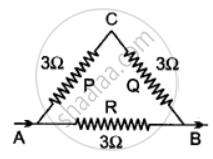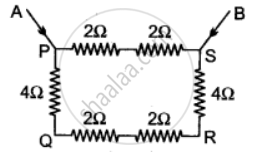Advertisements
Advertisements
प्रश्न
A wire that has resistance R is cut into two equal pieces. The two parts are joined in parallel. What is the resistance of the combination?
उत्तर
A wire that has a resistance, R is cut into two equal pieces.
The resistance of the each piece will be `R/2`
The two parts, each of resistance, R/2 are joined in parallel.
The resistance of the parallel combination:
`1/R^rho=1/R=1/R_1+1/R_2`
`Here R^1=R/2`
`=R_2=R/2`
`1/Rrho=1/(R/2)+1/(R/2)`
`1/Rrho=2/R+2/R`
`1/Rrho=4//R`
`Rrho=R/4`
Thus, the resistance of the combination will be R/4.
APPEARS IN
संबंधित प्रश्न
What are the advantages of connecting electrical devices in parallel with the battery instead of connecting them in series?
How will you connect three resistors of 2 Ω, 3 Ω and 5 Ω respectively so as to obtain a resultant of 2.5 Ω? Draw the diagram to show the arrangement.
State how are the two resistors joined with a battery when equivalent resistance is less than either of the two resistances.
Which of the following combinations have the same equivalent resistance between X and Y?
Calculate the equivalent resistance between the points A and B in Fig. if each resistance is 2·0 Ω.

A battery of e.m.f 16 V and internal resistance 2 Ω is connected to two resistors 3Ω and 6Ω connected in parallel. Find:
- the current through the battery.
- p.d. between the terminals of the battery,
- the current in 3 Ω resistors,
- the current in 6 Ω resistor.
What are the advantages of a parallel connection?
The equivalent resistance of a parallel combination of two resistors of 30 Ω and 60 Ω is ______________.
Calculate equivalent resistance in the following cases:


